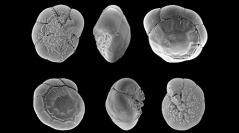

 Comptes Rendus Palevol
10 (2-3) - Pages 95-105
Comptes Rendus Palevol
10 (2-3) - Pages 95-105Molecular phylogenetics gives new insights into the taxonomy of foraminifera, independent of their morphology. After a survey of the present knowledge on how molecular phylogeny can contribute to foraminiferal taxonomy, we present an applied example. The comparison of ribosomal DNA (rDNA) sequences belonging to the SSU (Small Subunit) and LSU (Large Subunit) genes of Pseudoeponides falsobeccarii with other similar sequences of rotaliids available in GenBank shows that this species actually belongs to the genus Ammonia, because it groups inside the other Ammonia sequences instead of forming a distinct clade. Moreover, Ammonia falsobeccarii forms a clade well separated from other Ammonia phylotypes, meaning that it can be considered as a distinct species, and not as an ecophenotype of one of the other Ammonia species.
Benthic foraminifers, Rotaliida, SSU and LSU rDNA, Classification